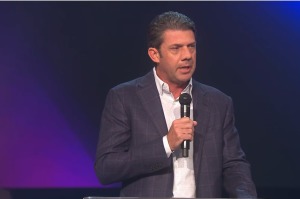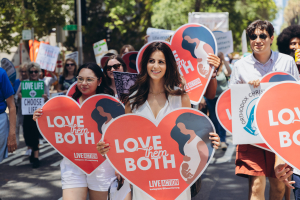The Final Sacrifice
"I am the good shepherd. The good shepherd lays down His life for His sheep." (John 10:11 NIV)
Jesus often referred to Himself as a shepherd. Perhaps because, even today, the image of a shepherd is one that depicts comfort, security, peace and love. There is nothing so tender as a shepherd caring for his sheep. In this instance, He says He is the "good shepherd", who will lay down His life for His sheep. Never again would man have to offer a blood sacrifice for any sin. Jesus' sacrifice was the ultimate and the final sacrifice.
Beginning in the Garden of Eden (Genesis 3:21), when God killed an animal and made clothing for Adam and Eve, God began to show us that sin could only be covered by a blood sacrifice. Although the Bible does not tell us what animal God killed to make clothing for Adam and Eve, I think it might have been a perfect lamb – a foreshadowing of the perfect Lamb of God who would die for you and me. Later, when God sent the final plague to Egypt – the slaying of the firstborn of all humans and animals alike – it was the blood of perfect one-year-old lambs, spread over the sides and tops of the doorframes of the Hebrews that protected the people of Israel from the Angel of Death. On that night, God established the Passover feast – the meat of the slaughtered lambs was to be roasted, and a portion given to each person in the household. They would eat the meat, along with bitter herbs, and unleavened (made without yeast) bread, and drink red wine. Later, the unleavened bread and red wine would be used by Jesus to symbolize His sinless body (unleavened bread, because the yeast in leavened bread represents sin), and His blood shed in sacrifice (the red wine), and establish Communion (or the Sacrament of the Lord’s Supper) that we celebrate today as Christians.
After their exodus from Egypt, and while the Hebrews were wandering in the wilderness, God established a priesthood, made up solely of the descendants of Levi. Sometimes called the Levitical Priesthood or the Priesthood of Aaron (Moses’ brother who was the first high priest), these men were given the singular role of “mediators” between God and men. These men were consecrated as priests, given very elaborate garments to wear, and given specific instructions as to their roles as mediators (Exodus 28 & 29). Then God told Moses to build the Tabernacle (Exodus chapters 25-27, 30, 35-40) – a “portable Temple” that was built sometime between the 15th and 13th centuries B.C. which the Hebrews carried with them throughout their wanderings, and which continued to be used for many, many years as the place where the hundreds of animals were sacrificed for the sins of the people.
God revealed the plans for the Temple to David (1 Chronicles 28:11-19), but told David that he would not be the one to build the temple because God did not want a warrior to build His Temple. After Solomon became King (the most unlikely choice by human standards because he was David’s son through Bathsheba, the woman with whom he committed adultery, and whose husband David murdered), God instructed Solomon to build the Temple in Jerusalem (1 Kings 5 – 8), and from the day that exquisitely beautiful building was constructed until 70 A.D., it would be the place where all Jews would come to offer perfect lambs and doves so that the priests could make blood sacrifices to cover their sins. The Bible tells us that God commanded construction of the tabernacle (and later temple) because of His desire to dwell among His people (Exodus 25:8; 1 Kings 6:12,13). However, in its design and its activities, the temple emphasized the separation of sinful man from God and the difficulty in approaching His divine presence under the old covenant.
Only the priests could enter the temple sanctuary. The sanctuary had two rooms: an outer chamber, called the "Holy Place," and an inner room, called the "Holy of Holies,” which was separated from the Holy Place by a massive veil – a 14-inch-thick intricately woven tapestry that was so sturdy that it was said that two teams of oxen pulling in opposite directions couldn’t even put a wrinkle in it. Worshippers could enter neither place; they were allowed to go no further than the altar of burnt offering in the courtyard. Only the priests entered the temple, where they ministered in the Holy Place on behalf of the people. The Holy of Holies was the place of God’s special presence. Only the high priest could go behind the massive Temple veil, and he could do that only one time a year on the Day of Atonement (Yom Kippur). What he did there is spelled out in detail in Leviticus 16:2-34 (also see Hebrews 9:7).
On the day that Jesus was crucified everything changed. At the moment of Jesus’ death, God Himself tore the Temple veil in two from top to bottom – an action that was impossible for men to do. But God made short work of that massive veil, in a symbolic act that said to the Hebrews – and to the world – that no longer would mankind need a priesthood to mediate between Him and them. From that moment forward, there would be “…one mediator between God and men, the man Christ Jesus,” (1 Timothy 2:5b). Then, God pushed His agenda forward even further by allowing the Temple to be destroyed in 70 A.D. There was no more need for a Temple, because there was no more need for blood sacrifice – the only activity ever performed in the temple. Jesus had become the FINAL blood sacrifice – the perfect Lamb of God who took away the sins of the world - ending for all time the need for a Temple or for the slaughter of thousands of lambs and doves. Three days after Jesus died on the cross, God’s plan of salvation was completed when Jesus rose from the dead, conquering death and hell forever for all who will believe.
This day, ponder on the fact that God’s plan for you and me was established before the earth was formed, and that from the Garden of Eden to Calvary, God’s plan was revealed throughout His Holy Word. Today, think about the magnificent extent of the sacrifice Jesus made for you and me. Think about how difficult it must have been for the incomprehensible expanse of God to be limited to a mortal body. Think about the agony He felt as He prayed in the Garden of Gethsemane, knowing what He was facing in just a few short hours... how the human in Him wanted desperately to stop the progression of events and to avoid the inevitable sacrifice He was about to make, and how – because He was 100% man and 100% God – His divinity overcame His humanity at that most difficult hour. Think about the exhaustion He experienced as He was forced to go through seven trials in one long and agonizing night. Think about the humiliation He experienced as His friends ran away, and as He was forced to stand before one judge after another, being ridiculed and spat upon by others. Think about the physical pain He felt when He was beaten until his flesh hung in shreds, with bone and sinew exposed on His back, and the crown of thorns was jammed down upon his head, ripping the flesh of His scalp and face. Think about the pain of having huge spikes driven through His hands and feet, and the surge of pain as the cross was lifted and dropped into its hole in the ground. But most of all, try to imagine the unimaginable – the indescribably agony He felt when the Holiness of the Father turned His back on the Son who had become SIN for you and me – the day that God literally tore Himself in two in order to spend eternity with those who will believe.
Think about the fact that He died for all mankind, even though so many millions hated Him and hate Him now. Think about the fact that He willingly would have gone to the cross, even if you had been the only one He could save by doing so. Think about how deep and unconditional His love is for you. Think about how blessed you are to no longer call yourself a sinner, but a saint – not for anything that you have done, but because of the sacrifice He made for you. Think about the moment-by-moment impact of His sacrifice on your life today – and the impact that sacrifice has on all eternity for you.
From Newsong Ministries
Newsong6@bellsouth.net
Used with Permission.




























